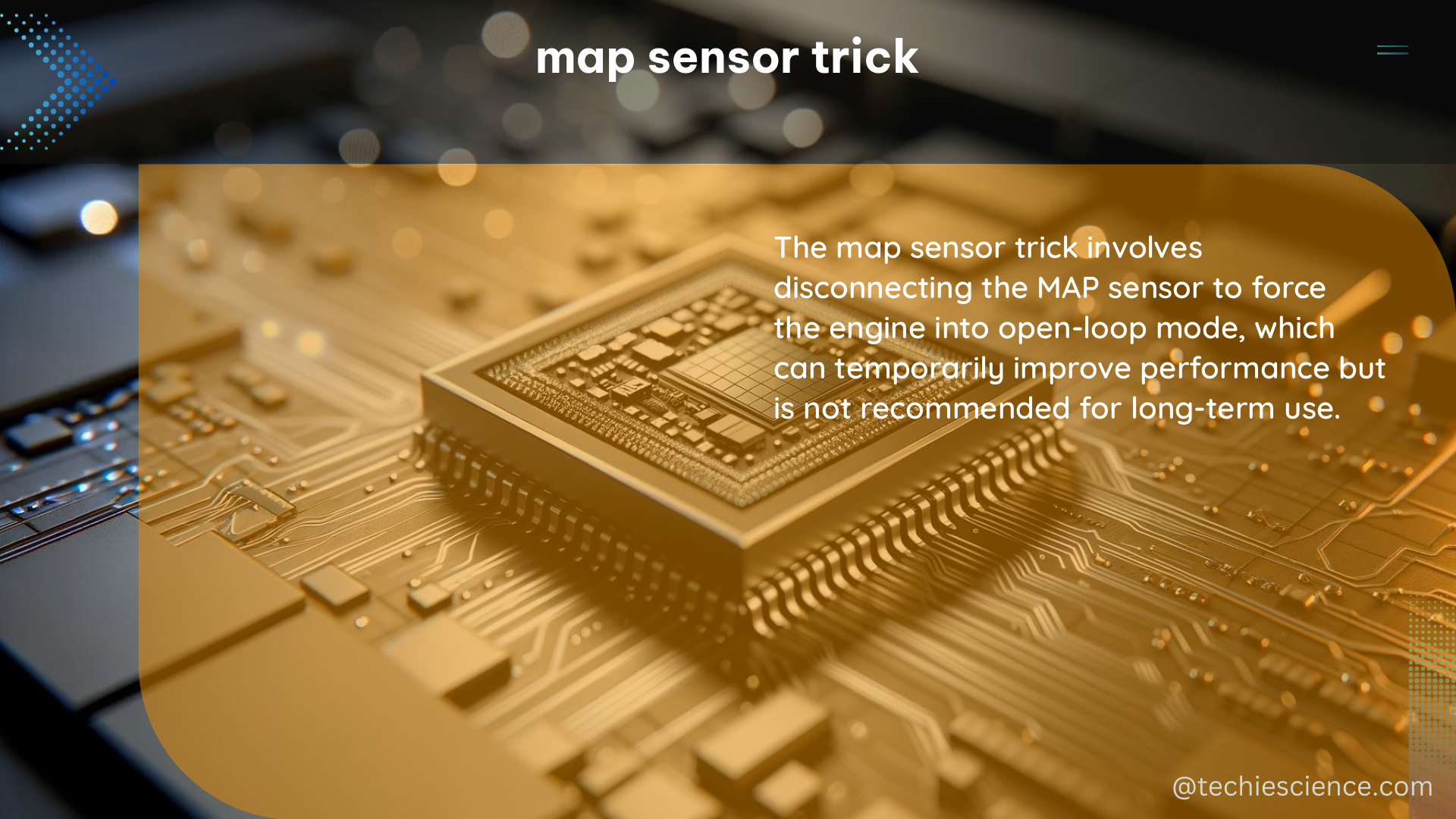The Manifold Absolute Pressure (MAP) sensor is a critical component in modern vehicles, providing real-time data on the engine’s intake manifold pressure. This information is essential for the engine control unit (ECU) to optimize fuel injection, ignition timing, and other critical parameters for efficient and clean combustion. The “MAP sensor trick” is a technique that has gained popularity among racing enthusiasts and mechanics, aiming to enhance engine performance by manipulating the MAP sensor readings.
Understanding the MAP Sensor
The MAP sensor measures the absolute pressure in the engine’s intake manifold, which varies based on the engine’s load and speed. This information is used by the ECU to calculate the air density and adjust the fuel injection accordingly, ensuring the optimal air-fuel ratio for efficient combustion.
The MAP sensor is typically a piezoresistive device that converts the pressure in the intake manifold into an electrical signal. The voltage output of the MAP sensor is proportional to the absolute pressure in the intake manifold, with a higher voltage indicating a higher pressure.
The MAP Sensor Trick Explained

The MAP sensor trick involves introducing a vacuum leak or adjusting the MAP sensor’s signal to the ECU, which can result in increased airflow and, consequently, higher engine power output. This is achieved by either:
-
Vacuum Leak: Creating a small vacuum leak in the intake system, which can be done by partially blocking the MAP sensor’s vacuum line or introducing a small hole in the intake manifold. This causes the MAP sensor to read a lower pressure, tricking the ECU into thinking there is more airflow, leading to increased fuel delivery and potentially higher power output.
-
Signal Adjustment: Directly manipulating the MAP sensor’s electrical signal by using a resistor or a potentiometer to adjust the voltage output. This can be done by intercepting the MAP sensor’s signal wire and introducing a variable resistance, which can be tuned to achieve the desired effect.
Potential Risks and Drawbacks
While the MAP sensor trick can result in increased engine power, it is crucial to understand the potential risks and drawbacks associated with this technique:
-
Inaccurate Fuel Metering: Manipulating the MAP sensor readings can lead to inaccurate fuel metering, which may result in a rich or lean air-fuel mixture. This can lead to increased emissions, reduced fuel efficiency, and potential engine damage.
-
Engine Damage: Introducing a vacuum leak or altering the MAP sensor’s signal can disrupt the ECU’s ability to accurately control the air-fuel ratio, which can lead to engine knocking, pre-ignition, or other issues that can cause engine damage over time.
-
Emissions and Legality: Modifying the MAP sensor’s operation may result in increased emissions, which can be illegal in many jurisdictions. This can lead to issues with vehicle inspections and compliance with environmental regulations.
-
Warranty Implications: Tampering with the MAP sensor or other engine components may void the vehicle’s warranty, leaving the owner responsible for any resulting damage or issues.
Proper Tuning and Monitoring
To mitigate the risks associated with the MAP sensor trick, it is essential to have a thorough understanding of engine tuning principles and to approach any modifications with caution. Proper tuning and monitoring are crucial to ensure the engine’s performance, efficiency, and longevity.
-
Professional Tuning: It is recommended to have a qualified engine tuner or mechanic perform any modifications to the MAP sensor or the engine’s tuning parameters. They can ensure that the changes are made safely and effectively, while also monitoring the engine’s performance and emissions.
-
Data Logging: Utilizing data logging tools to monitor the engine’s performance, including the MAP sensor’s readings, can help identify any issues or imbalances in the air-fuel ratio or other critical parameters.
-
Emissions Testing: Regular emissions testing can help ensure that the engine is operating within legal limits and that any modifications have not resulted in excessive emissions.
-
Maintenance and Inspection: Proper maintenance and regular inspection of the engine and its components, including the MAP sensor, can help identify any issues or wear and tear that may affect the engine’s performance and efficiency.
Conclusion
The MAP sensor trick can be a powerful tool for enhancing engine performance, but it should be approached with caution and a thorough understanding of the potential risks and drawbacks. By working with qualified professionals, utilizing data logging and emissions testing, and maintaining the engine’s components, enthusiasts and mechanics can explore the benefits of the MAP sensor trick while ensuring the engine’s long-term health and compliance with relevant regulations.
References:
- NASA Spinoff 2024: Satellite Data Informs Sustainable Land Management
- Analysis Techniques for Race Car Data Acquisition
- Why do humans exclusively possess intelligence?

The lambdageeks.com Core SME Team is a group of experienced subject matter experts from diverse scientific and technical fields including Physics, Chemistry, Technology,Electronics & Electrical Engineering, Automotive, Mechanical Engineering. Our team collaborates to create high-quality, well-researched articles on a wide range of science and technology topics for the lambdageeks.com website.
All Our Senior SME are having more than 7 Years of experience in the respective fields . They are either Working Industry Professionals or assocaited With different Universities. Refer Our Authors Page to get to know About our Core SMEs.